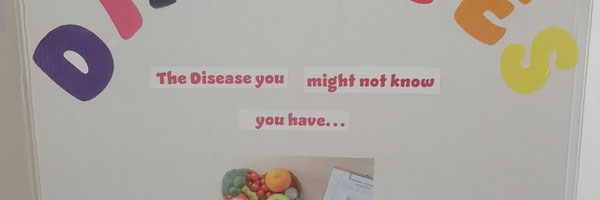Diabetes: The disease you might not know you have
Alisha Bidgood Eva Moores
Grade 5
Presentation
Problem
This project is about Diabetes and understanding what causes it, treat it and how to prevent it.
People may not know enough about diabetes.
In this presentation, we will answer the following questions to bring awareness:
What is diabetes and how do we take care of it, what ways can we prevent it, and what types are there?
What happens when you get diabetes, and if your blood sugar gets too high or too low what will happen?
Method
We researched about the pancreas, Insulin, the main types of diabetes, ways we can prevent diabetes, and what types there are.
Research
The body needs energy to work. Glucose is a natural sugar found in plants that give energy to living things.
The pancreas is an organ in the human body that makes insulin which helps the body use sugar. Sometimes the pancreas doesn’t make enough insulin, so we can’t absorb glucose. It may lead to heart or kidney failure or even death.
Diabetes is the disease when your body doesn't make enough insulin or can’t use it as well as it should. It can affect every part of your body. There are two types of diabetes: Type 1 and Type 2.
Doctors Sir Fredrick Banting and Charles Best discovered that insulin can treat diabetes. The first person treated with insulin was on January 11, 1922.
Insulin helps lower the glucose number.
If the glucose number is too high, there is too much sugar in the blood and you need insulin. When your blood sugar is too high, you may feel tired, thirsty, frequent urination or lose weight.
If the glucose number is too low, there is not enough sugar in the blood. The medical name for low blood sugar is hypoglycemia but you can also call it a low blood sugar episode. A sugary snack will help raise the glucose number. A very high or low number might mean a trip to the hospital.
There are 4 types of insulin, 2 types of basal and 2 types of mealtime insulin.
You can take insulin in forms of inhaling it, having an insulin patch, an insulin pump or injecting it. When you take insulin you should not inject in the same spot or it will get infected.
If you have diabetes your body can easily get damaged in areas such as blood vessels in the heart, eyes, kidneys, and nerves. People with diabetes are more likely to develop mouth and skin infections.
If you have diabetes, you should eat healthy meals. Yogurt containing a lot of sugar, and fruit juice are a few things not to eat if you have diabetes. You can still have late night snacks but keep it healthy.
Physical activity also lowers your blood sugar so it is important for people with diabetes to do activities that include movement.
You can live with type 2 diabetes without knowing because it develops slowly in your body. Type 2 diabetes can be caused by being overweight and not getting enough physical activity.
There is a good chance that people with diabetes will live as long as a person without the condition.
Data
Type 1 Diabetes
- Less common
- Usually starts during childhood
- Pancreas does not make enough insulin
- No cure
- Not preventable
Type 2 Diabetes
- More common
- Usually starts during adulthood
- Pancreas makes insulin but the body can not use it
- No cure
- Preventable
We learned that diabetes is not something funny, it is important that you take care of it and know what to do.
Conclusion
In conclusion, we learned that diabetes can be a serious disease so you should take good care of yourself and people diagnosed with diabetes.
Citations
https://www.mayoclinic.org/diseases-conditions/diabetes/diagnosis-treatment/drc-20371451
https://pixabay.com/images/search/diabetes/
https://www.cdc.gov/diabetes/images/basics/CDC_Diabetes_Social_Ad_Concept_A2_Facebook.png
Peterson, A. (2016). What you need to know about Diabetes. Capstone Press.
Graham, K and Shomali, M. (2020). Complete Diabetes Guide. (2nd). Robert Rose Inc.
Acknowledgement
We acknowledge Ms O'Brien and Ms Kowalski, the science fair coordinators.

